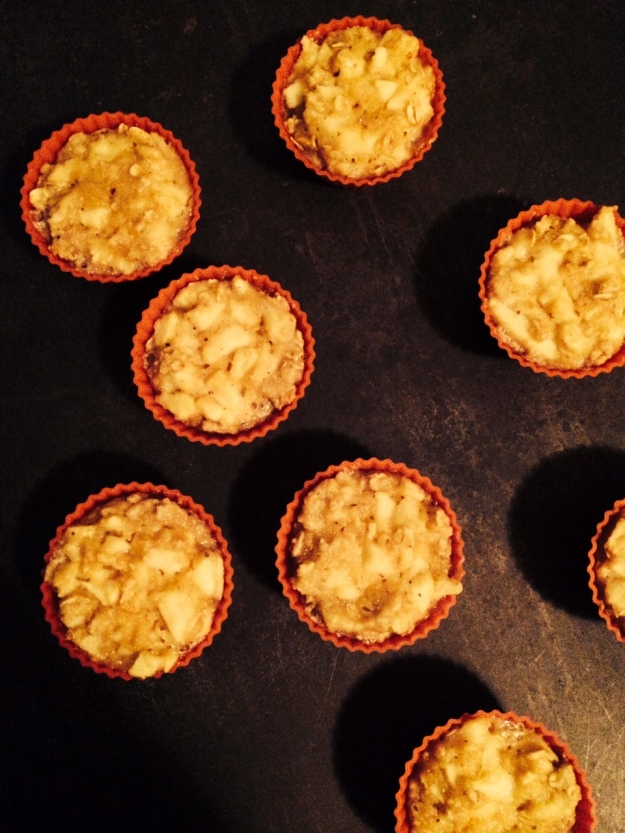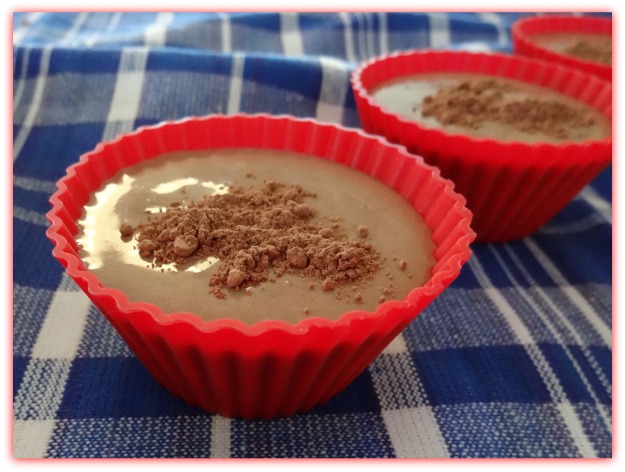More Buying Choices for Mrs Andersons Baking Easyaspie Pie Plate

When Life Gives you Apples, Pears and Peaches, Make Pie!
Whichever kind of pie you're baking, the Mrs. Anderson's Baking Pie Shield is sure to be one of your favorite pie-baking tools. The new and improved Mrs. Anderson's Pie Shield fits 9.5-inch and 10-inch pie plates, including those with fluted edges (such as our own Easy as Pie Pie Plate). Simply place the shield over the pie before baking, and the shield keeps crusts from over browning, allowing the pie to rise in the middle while reducing spillage.

Autumn Apple Muffins
If you're in the mood to bake using traditional fall flavors like apple and cinnamon, and are looking for an alternative to a traditional wheat flour based muffin recipe, these autumn apple muffins just might delight! The texture is soft and very moist, almost cake-like, and the flavor is apple-rich due to the high fruit to dough ratio. My first experience enjoying these was on the back porch of a friend's home, eaten with a mug of hot cider and a view of the turning autumn leaves. Her baking experiments often include trying flour alternatives like coconut flour, almond meal, quinoa, and more, and I'm always intrigued and impressed at the delicious treats she creates. This apple muffin recipe is my favorite of hers, capturing some of the beauty and flavors of fall.

Autumn Apple Muffins in Mrs. Anderson's Baking Silicone Muffin Cups
Ingredients:
- 1 ½ cups almond meal
- ½ cup oats
- 2 teaspoons cinnamon
- ½ teaspoon sea salt
- ½ teaspoon baking soda
- ¼ cup honey
- 3 eggs
- 2 tablespoons olive oil
- 1 large peeled and chopped tart apple
Kitchen Tools:
- The World's Greatest™ 3-in-1 Rotational Tri-Blade Peeler
- Mrs. Anderson's Baking® Silicone Muffin Cups
- Mrs. Anderson's Baking® Measuring Cups
- Mrs. Anderson's Baking® Measuring Spoons
- Mrs. Anderson's Baking® Muffin Tin
- HIC Stainless Steel Mixing Bowl
- HIC Silicone Spatula
Instructions:
Preheat oven to 320. Line a muffin tin with paper or silicone baking cups. Mrs. Anderson's Baking® Silicone Muffin Cups are used and pictured in this recipe.
Peel, core, and chop 1 large apple, and set aside.

Peeling a large apple with The World's Greatest 3-in-1 Rotational Tri Peeler
Place almond meal, oats, cinnamon, sea salt, and baking soda in a large bowl and mix until combined. Then add eggs, honey, and olive oil, and mix until combined but don't beat. Next, fold in the chopped apples.

Chopped Apples
Fill each baking cup to the top, as they don't rise as much as a muffin made with wheat flour.
Bake for 20 minutes. They'll be a bit gooey at the tops until they cool. Makes about 1 Dozen Muffins.

Autumn Apple Muffins in Mrs. Anderson's Baking Silicone Baking Cups
Contributed by Nicole Herman, of HIC.

Classic Rolling Pin Illustration
Article Contributed by Laura Everage
Anyone who has spent any time in the kitchen will tell you that there certainly are essential tools to help you get through mealtime. If you're an avid home cook, you'll stock your kitchen with everything from sharp knives to well-seasoned cast iron cookware. And, if you're a baker, you know that there is one tool that you just can live without . . . the rolling pin. In fact, the rolling pin is a tool that transcends both the cooking and baking genres, proving itself to be an indispensable tool for making sweet or savory pies, noodles, fondant, puff pastry, flatbreads and more.
There are rolling pins for all occasions and choosing the right one for a specific purpose is important. For most home cooks, a wooden rolling pin will prove the most versatile and serves best as an all-purpose rolling pin. Whether it is for preparing pastry for sweet or savory pies, flattening yeast-raised dough for pizza, making cut-out cookies, or cranking out udon noodles, the wooden rolling pin helps get the job done.
While professionals often choose a lightweight, handle-less wooden pin, such as a baker's or French pin pictured below, most home bakers feel most comfortable with a heaver and handled wooden pin. The wooden rolling pin allows for easier flattening of dough, and the slightly larger barrel requires fewer revolutions, making the task easier.

Mrs. Anderson's Baking Rolling Pins from Harold Import Co., made of hardwood in the USA.
Many of us have a hand-me-down wooden rolling pin in our kitchens. This pin has served its purpose well through the years, effectively and efficiently performing the task at hand. However, if you have yet to receive the hand-me-down pin from your mother, or are seeking to add a new one to your kitchen essentials toolbox, here are a few things to consider when purchasing a wooden rolling pin:
- Wooden rolling pins can be made of various types of woods including maple, walnut and cherry. Each wood has distinctive properties, so choose a high quality wood to suit your needs. Strong and heavy, a hardwood is a great choice to resist abrasions through the years.
- The desired length of a wooden rolling pin is with a 3-inch diameter of the barrel and can vary from 12-18 inches, with somewhere in between being one that suits most needs.
- A good quality wooden rolling pin will last long enough to hand it down to the next generation. If possible, give it a roll in the store. It should easily roll, and give your knuckles ample room to move across the dough without knocking your knuckles on the dough or pastry board.
Quick Tips on Cleaning Wooden Rolling Pins:
- Don't leave a wooden rolling pin in water or the dishwasher – it may warp or crack, or cause damage to the bearings in the handle.
- Wipe with a dry paper towel, then follow up with a damp cloth. If necessary, lightly use a scouring pad.
- You don't want to use soap because it may seep into the wood.
A Classic in the Kitchen
One of the classics of baking is making your own pie dough. While it may seem daunting for some, keep in mind it requires only a few ingredients (flour, Crisco, salt and water), and a little patience. When you have a classic kitchen tool such as the wooden rolling pin on hand, you'll have it mastered in no time.
If you are wondering how to make a flawless, flaky pie crust, head on over to Family Eats to get a few tips on making the perfect pie crust.

Cacao, Almond Milk, and Banana Ice Cream
With summer in full swing, a cool treat is always appreciated. We explored venturing beyond our traditional ice cream recipes, and pulled in a few nutritious ingredients to make this rich, chocolatey cacao, almond milk, and banana ice cream.

Cacao Ice Cream Recipe
Cacao, Raw Almond Milk, and Banana Ice Cream Recipe

Cacao Powder
This recipe produces an "ice cream" with an incredibly rich, dark chocolate flavor imparted by the cacao powder, and has a creamy mouthfeel from the homemade almond milk. (You could use store bought almond milk, but the flavor and texture will be a little different.)
Any sweetener of choice can be used in this recipe, but we found that honey and agave nectar both pair well with the rich tasting cacao.
This ice cream was made using a blender and frozen bananas, which is great if you want to get this dessert on the table quickly. If you have an ice cream maker you could first blend all ingredients at room temperature, then transfer to an ice cream maker to freeze.

Cacao Powder
Ingredients:
- 2 heaping Tbsp Cacao Powder
- 2 Tbsp Raw Honey or Agave Nectar (or stevia for the sugar sensitive)
- 1/3 cup cold Homemade Almond Milk using raw almonds (see our recipe here)
- 2 large frozen bananas (break in 1-inch pieces before freezing)
Tools:
![]()
Mrs. Anderson's Baking Silicone Baking Cups and Royal Blue Box Plaid Kitchen Towel Available from HIC
- Blender
- Measuring spoons
- Big spoon or spatula to pull ice cream from blender (Pictured is HIC's French Beechwood Spoon)
- Dishes for ice cream (Pictured are Mrs. Anderson's Baking Silicone Muffin Cups)
Place almond milk, cacao powder, and honey or agave in blender and pulse to start mixing slowly. Turning on high power without slowly mixing the cacao powder into the liquid first can cause it to shoot upwards in a cloud of cocoa dust. After almond milk, cacao powder, and honey are mixed gently, increase speed for a few seconds and mix well. Add frozen banana pieces, and pulse to get them moving. Then blend on high until the banana chunks smooth out and an ice cream consistency results. Serve at once, and sprinkle with additional cacao powder if desired. The deep chocolate taste is downright decadent.
*Hot weather tip: If you're in an especially warm climate, or warm kitchen, ice cream can start to melt quickly after served. Try pouring into chilled ice cream cups (store them in the freezer) to help keep ice cream from melting quickly.
We appreciate our readers, and are interested in hearing more about your culinary adventures. Drop us a line and share what you're experiencing! We'd love to hear your thoughts, anytime the mood strikes you.
Contributed by Nicole Herman, of HIC.
Source: https://hickitchenblog.com/tag/mrs-andersons-baking-tools/
0 Response to "More Buying Choices for Mrs Andersons Baking Easyaspie Pie Plate"
Post a Comment